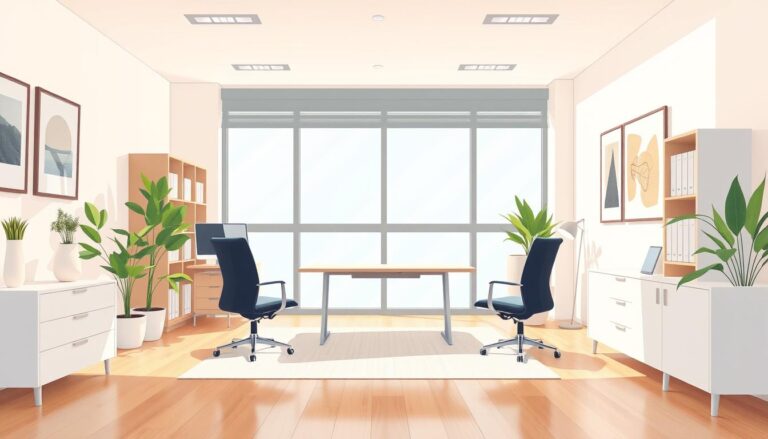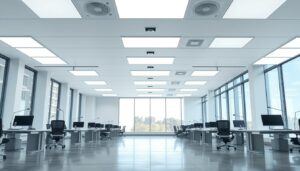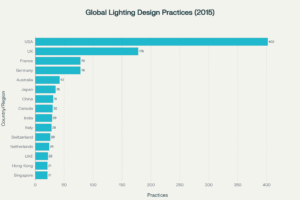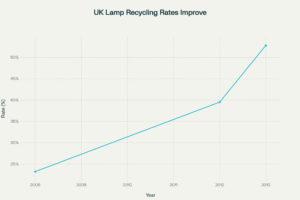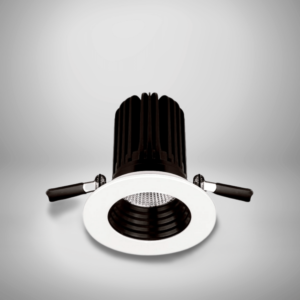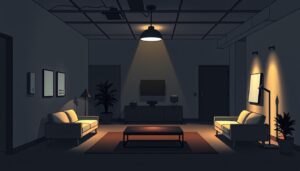Did you know that lighting can account for up to 50% of a commercial building’s electricity use? This surprising fact highlights just how much impact your lighting choices can have on both your bills and the environment. For businesses across the UK, this presents a significant opportunity to make smarter, more sustainable decisions.
Outdated systems not only consume more power but also require frequent maintenance, adding unnecessary costs. By transitioning to modern solutions like LED technology, you can achieve substantial savings while improving the overall ambience of your workspace. The benefits go beyond just reduced expenses—better lighting can enhance employee well-being and productivity too.
In this article, we’ll guide you through practical steps to optimise your lighting setup. From choosing the right luminaires to implementing smart lighting control, we’ll provide expert advice to help you make informed decisions.
Understanding Commercial Lighting Consumption in Office Spaces
The way we illuminate workspaces has a direct effect on both finances and the environment. In many commercial settings, outdated systems consume far more electricity than necessary, driving up operational costs.
Traditional fluorescent and incandescent bulbs are particularly problematic. They waste a significant portion of electricity as heat rather than light. This inefficiency not only increases your bill but also contributes to a larger carbon footprint. For businesses, this means higher expenses and a greater environmental impact.
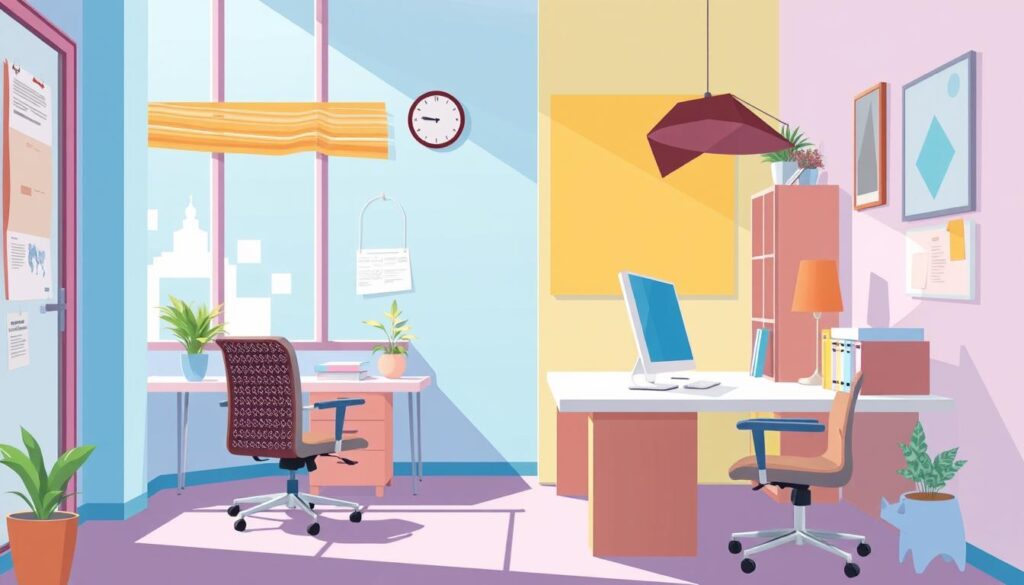
Upgrading to modern solutions can address these issues. For example, LED technology uses up to 75% less electricity than older bulbs. This reduction in consumption translates to lower bills and fewer carbon emissions. The financial and environmental benefits make it a smart choice for any commercial space.
By understanding the impact of inefficient systems, businesses can make informed decisions. Reducing energy consumption not only saves money but also supports sustainability goals. It’s a win-win for both your building and the planet.
Switching to Modern LED Lighting for Superior Energy Savings
Modern LED systems with their advanced technology offer a practical and sustainable solution for businesses. By making the switch, you can enjoy significant benefits that go beyond just cost savings.
Benefits of LED Upgrades
LEDs are designed to maximise brightness while minimising waste. Unlike traditional bulbs, they convert nearly all electric energy into light, reducing heat loss. This makes them an efficient lighting choice for any workspace.
Reduced Maintenance and Extended Lifespan
One of the standout benefits of LEDs is their longevity. With a lifespan of up to 50,000 hours, they outlast traditional bulbs by decades. This means fewer replacements and lower maintenance costs over time.
For businesses, this translates to long-term savings. Imagine not having to replace bulbs every few months. LEDs are a reliable solution that keeps your space illuminated without constant upkeep.
Enhancing Ambience in Office Environments
LEDs offer superior brightness and colour quality, enhancing the overall ambience of any space. Whether it’s for focused task work or creating a welcoming atmosphere, they deliver consistent performance.
Customisable options allow you to adjust the brightness and tone to suit different needs. This flexibility makes LEDs an ideal solution for creating productive and comfortable environments.
By upgrading to efficient lighting, you’re not just saving money—you’re improving the quality of your workspace.
Strategies for Enhancing Office Lighting Energy Efficiency
Improving how we light up workspaces doesn’t have to be complicated. With the right strategy, you can create a comfortable and productive environment while reducing unnecessary use of resources. Let’s explore some practical techniques to achieve this.
Choosing the Right Luminaires
Selecting appropriate fixtures is the first step. Opt for luminaires that distribute light evenly across the room, avoiding glare and shadows. This ensures a balanced setup that supports work tasks without straining the eyes.
Implementing Motion Sensors
Installing motion sensors in areas like meeting rooms and corridors can significantly reduce waste. These devices automatically switch off when no one is present, ensuring lights are only in use when needed.
Creating Controlled Lighting Zones
Divide your space into zones tailored to specific tasks. For example, brighter areas for detailed work and softer illumination for relaxation spaces. This strategy ensures each room is lit appropriately, enhancing both comfort and efficiency.
Reducing Glare and Uniform Light Levels
Glare can cause discomfort and reduce productivity. Use fixtures with diffusers or shields to minimise this issue. Aim for uniform light levels across the room to create a consistent and pleasant environment.
Auditing Your Current Setup
Regularly assess your existing system to identify areas for improvement. Look for outdated fixtures, excessive use in low-traffic areas, or uneven illumination. Small changes can lead to significant efficiency gains.
By adopting these strategies, you can transform your workspace into a more sustainable and comfortable environment. Start with a simple audit and take it step by step—every improvement counts.
Adopting Smart Lighting Controls and Occupancy Sensors
Occupancy sensors are transforming the way we think about workspace illumination. These devices, paired with smart controls, ensure that resources are used only when needed. By automating systems, we can significantly reduce waste and enhance sustainability.
Automation for Energy Management
Smart controls allow us to manage illumination more effectively. For example, motion sensors can detect when a room is unoccupied and switch off the lights automatically. This simple technology can cut unnecessary usage by up to 30%, according to studies.
Automation also extends to scheduling. Lights can be programmed to dim or turn off during off-peak hours. This not only saves time but also reduces operational costs. Integrating these systems with modern LED setups maximises their potential.
Types of Sensors and Their Applications
Different sensor types suit various environments. Microwave sensors operate by emitting high-frequency electromagnetic waves (typically 5.8GHz) and measuring the reflection pattern changes when movement occurs. Their ability to penetrate non-metallic materials makes them ideal for large, complex spaces with partitions or cubicles, detecting even subtle movements like typing or breathing. These sensors provide consistent coverage regardless of ambient temperature, though they may occasionally trigger from movement outside the intended detection zone.
PIR (Passive Infrared) sensors function by detecting changes in infrared radiation naturally emitted by human bodies. They excel in smaller, contained areas with clear sight lines, as they require direct line-of-sight to function effectively. While highly energy-efficient and less prone to false triggering than microwave sensors, PIR technology becomes less reliable in environments with significant temperature fluctuations or when movements are very subtle. Their detection pattern typically consists of segmented zones rather than continuous coverage.
In meeting rooms, sensors ensure lights are only active during use. Corridors and storage areas benefit from motion detection, reducing waste in low-traffic zones. By choosing the right sensor, we can tailor solutions to specific needs.
These systems not only save resources but also contribute to broader sustainability goals. By reducing consumption, businesses can lower their carbon footprint while improving operational efficiency.
Utilising Daylight and Natural Light Optimisation
Natural light isn’t just a design choice—it’s a game-changer for productivity and well-being. By maximising daylight in your workspace, you can create a brighter, healthier environment while reducing reliance on artificial sources. Studies show that effective daylighting can cut electric usage by up to 40%, making it a smart move for both sustainability and cost savings.
Leveraging Window and Skylight Placement
Strategic placement of windows and skylights is key to optimising sunlight. Positioning workstations within 4.5 to 6 metres of windows ensures ample exposure. Skylights, on the other hand, can bring daylight into deeper areas of the building, reducing the need for artificial sources.
Using glazed partitions or light shelves can further enhance natural light penetration. These design elements not only brighten the space but also create a more open and inviting atmosphere.
Integrating Daylighting in Office Design
Incorporating daylighting into your design plan requires careful planning. Automated blinds and sensors can adjust light levels based on the time of day, ensuring optimal illumination without glare. Prismatic panels and light tubes are also effective for directing sunlight into areas with no direct access to windows.
Balancing natural light with artificial sources is crucial. A well-designed system ensures consistent brightness, reducing eye strain and enhancing visual comfort.
Boosting Productivity through Natural Illumination
Exposure to natural light has a direct impact on productivity. Research shows it can increase focus and alertness by up to 15%. Employees working in well-lit environments report fewer headaches and a 51% reduction in eye strain.
Beyond physical benefits, daylight also improves mood and well-being. Studies indicate a 25% increase in overall happiness among employees with access to ample sunlight. By prioritising natural light, you’re not just enhancing the workspace—you’re investing in your team’s health and performance.
Retrofitting Fluorescent Fixtures and Upgrading Lighting Technology
Modernising fluorescent setups offers more than just cost benefits. By retrofitting outdated fixtures, we can achieve better performance, improved colour rendering, and a reduced environmental impact. It’s a practical step towards sustainability and enhanced workspace quality.
Transitioning to Energy-Efficient Alternatives
One of the most effective upgrades is replacing traditional fluorescent lamps with T8 bulbs and electronic ballasts. These modern alternatives consume less power while delivering superior light quality. They eliminate issues like flickering and poor colour accuracy, creating a more comfortable environment.
For example, T8 lamps use up to 40% less electricity than older models. This reduction not only lowers bills but also extends the lifespan of the bulbs, reducing maintenance costs. It’s a smart investment that pays off quickly.
Improving Lighting Quality and Colour Rendering
Enhanced colour rendering is a key benefit of retrofitting. Modern bulbs provide a more natural and vibrant light, which can boost both comfort and productivity. This is particularly important in areas where visual tasks are performed, such as workspaces or retail settings.
Studies show that better colour accuracy can improve focus and reduce eye strain. By upgrading, we create a more pleasant and efficient environment for everyone.
- Cost Savings: Lower electricity bills and reduced maintenance expenses.
- Environmental Benefits: Decreased carbon footprint and less waste.
- Enhanced Comfort: Improved light quality and reduced flickering.
Retrofitting is more than just an upgrade—it’s a step towards a brighter, more sustainable future. By adopting these solutions, we can make a positive impact on both our spaces and the planet.
Focusing on High-Use Areas for Maximum Savings
Certain spaces within a workspace consume more resources than others. By targeting these high-traffic zones, we can achieve significant reductions in operational costs and maintenance. Research shows that focusing on areas like entrances, corridors, and workspaces can deliver disproportionate savings.
Identifying Key Areas for Improvement
Entrances, corridors, and workspaces are often the most resource-intensive parts of a building. These areas require consistent illumination, leading to higher consumption. For example, corridors are typically lit 24/7, even when unoccupied, resulting in unnecessary waste.
Workspaces, on the other hand, demand bright, consistent light for work tasks. Without efficient systems, these zones can drive up bills and maintenance costs. By prioritising these high-use areas, we can maximise savings and improve overall efficiency.
Strategies for Upgrading High-Use Zones
Upgrading these spaces doesn’t have to be complex. Here are some practical strategies:
- Retrofitting: Replace outdated fixtures with modern alternatives like LEDs. This reduces consumption and extends lifespan.
- Sensor Integration: Install motion sensors in corridors and entrances to ensure lights are only active when needed.
- Zoning: Divide the space into zones tailored to specific tasks, ensuring each room is lit appropriately.
Practical Tips for Targeted Spaces
Here’s how to implement these strategies effectively:
| Area | Solution | Benefit |
|---|---|---|
| Entrances | Motion sensors | Reduces waste in low-traffic zones |
| Corridors | LED retrofitting | Lowers bills and maintenance costs |
| Workspaces | Task-specific zoning | Enhances comfort and productivity |
By focusing on these high-use areas, we can achieve significant savings and create a more sustainable building. Start with a simple audit and take it step by step—every improvement counts.
Taking Advantage of Financial Incentives for Energy Upgrades
Financial incentives can make upgrading to sustainable solutions more accessible than ever. Many businesses are unaware of the rebates, tax deductions, and utility offers available to offset costs. By exploring these options, you can significantly reduce the financial burden of modernising your setup.
Exploring Rebates, Tax Deductions, and Utility Offers
Utility companies and government agencies often provide attractive incentives for upgrading to eco-friendly systems. For example, the ECO 4 Scheme offers support for low-income households, while the Energy Savings Opportunity Scheme (ESOS) mandates energy audits for large enterprises. These programmes aim to reduce carbon footprint and promote sustainability.
Rebates can cover a portion of the cost for new fixtures, while tax deductions lower your overall liability. Utility offers may include discounts or low-interest financing for approved upgrades. By leveraging these incentives, you can make your project more affordable and impactful.
Calculating Return on Investment
Understanding the financial benefits of upgrades is crucial. Start by calculating the initial cost of new fixtures and installation. Then, factor in the savings from reduced consumption and lower maintenance. Many projects see a return on investment (ROI) within just a few years.
For instance, switching to LED technology can save up to 90% on electricity bills. With a lifespan of up to 25 times longer than traditional bulbs, the long-term savings are substantial. Here’s a simple breakdown:
Designing a Sustainable and Productive Office Environment
Thoughtful design choices in the workplace can lead to a more sustainable and productive environment. By focusing on elements like light levels and colour temperature, we can create spaces that enhance both employee well-being and operational performance.
Enhancing Well-being and Employee Satisfaction
Research by organisations like CIBSE and WELL shows that a well-designed workspace can significantly improve employee health and satisfaction. Proper light levels reduce eye strain and fatigue, while balanced colour temperatures support circadian rhythms, promoting better sleep and overall well-being.
For example, workspaces with access to natural light report higher levels of employee happiness. Studies indicate a 25% increase in job satisfaction when employees work in environments with ample daylight. This not only boosts morale but also enhances productivity.
Creating Visually Comfortable Workspaces
Visual comfort is key to a productive office. Glare-free lighting and uniform light levels ensure that employees can focus without discomfort. Incorporating adjustable task lighting allows individuals to tailor their environment to their needs, further enhancing comfort and efficiency.
Additionally, using warmer colour temperatures in relaxation areas and cooler tones in task-focused zones can create a balanced atmosphere. This approach supports both relaxation and concentration, catering to different work requirements.
Balancing Natural and Artificial Light
Natural light is a powerful tool in sustainable design. By maximising daylight through strategic window placement and skylights, we can reduce reliance on artificial sources. Automated blinds and sensors can adjust light levels throughout the day, ensuring optimal illumination without glare.
When artificial lighting is necessary, choosing energy-efficient options like LEDs ensures sustainability. These solutions not only reduce costs but also contribute to a greener office environment.
Holistic Design for Long-term Benefits
A holistic approach to workspace design considers both aesthetics and functionality. By integrating sustainable practices, we can create environments that support employee well-being while minimising environmental impact. This includes using eco-friendly materials, optimising light levels, and encouraging natural light wherever possible.
Facilities teams play a crucial role in this process. By prioritising thoughtful lighting design, we can transform workspaces into hubs of productivity and sustainability. It’s a win-win for both employees and the planet.
Conclusion
Making smarter choices in workspace illumination can transform both your budget and your team’s performance. By adopting LED technology, integrating smart controls, and maximising natural light, we can create spaces that enhance well-being and productivity. These strategies not only reduce costs but also contribute to a healthier environment.
Investing in modern solutions offers significant benefits. Employees in well-lit spaces report fewer headaches and higher job satisfaction. Additionally, financial incentives like rebates and tax deductions make upgrades more accessible, ensuring a strong return on investment.
By prioritising sustainability, we can reduce our carbon footprint while improving operational efficiency. A thoughtful design approach ensures that every space is both functional and comfortable, supporting long-term success.
Take the first step today. Audit your current setup and explore expert guidance to create a brighter, more sustainable future. Together, we can make a positive impact on both people and the planet.
FAQ
How can I reduce energy consumption in my workspace?
Switching to modern LED technology is a great start. LEDs use less electricity and last longer, reducing both your bills and maintenance needs. Pair them with smart controls like motion sensors for even greater savings.
What are the benefits of using natural light in offices?
Natural illumination not only cuts down on electricity use but also boosts productivity and well-being. Strategically placed windows and skylights can maximise daylight while enhancing the overall ambience of the space.
Are there financial incentives for upgrading to energy-efficient systems?
Yes, many utility companies and governments offer rebates, tax deductions, and other incentives for adopting sustainable solutions. These can significantly offset the initial costs of upgrading your fixtures.
How do smart lighting controls work?
Smart controls, such as occupancy sensors, automatically adjust brightness or turn off lights when a room is unoccupied. This automation ensures electricity is only used when needed, leading to substantial savings over time.
What should I consider when retrofitting fluorescent fixtures?
Focus on improving lighting quality and colour rendering. LEDs offer better brightness and colour accuracy, creating a more comfortable and productive environment while reducing your carbon footprint.
Which areas should I prioritise for lighting upgrades?
High-use spaces like entrances, corridors, and workspaces are ideal for upgrades. These areas benefit the most from energy-efficient solutions, delivering maximum savings and improved functionality.
How does lighting impact employee well-being?
Proper illumination, especially natural light, enhances mood, reduces eye strain, and improves focus. A well-lit environment contributes to higher satisfaction and productivity among staff.
